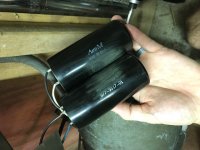Speedracer983
Plastic
- Joined
- Jun 27, 2017
Following for years, first time poster, thanks for taking the time to help.
In the process of prepping my home shop for some 3PH equipment (Saw, Mill and Lathe )
The rotary phase converter that I am running is a 7HP system taken out from a buddies home shop. Unfortunately he had minimal knowledge and just removed everything leaving it in a pile.
The system is wired ( to the best of my ability ) and working, generating 3PH power. My issue is when I shut the system down, with no load, meaning no machines are creating a draw, the idle motor makes a noise like it is receiving stray voltage and drastically reduces speed then coast to a stop in 5 or so seconds.
My buddy said it never did that and always "softly" shutdown, coasting to a stop in 30 to 45 seconds. I have gone over the wiring options several times with no luck. A tough question with my less than ideal explanation but any direction offered would be greatly appreciated.
Its a typical rotary system with 50A feed, traditional start and run capacitors, switching relay and a 7HP Baldor idle motor.
In the process of prepping my home shop for some 3PH equipment (Saw, Mill and Lathe )
The rotary phase converter that I am running is a 7HP system taken out from a buddies home shop. Unfortunately he had minimal knowledge and just removed everything leaving it in a pile.
The system is wired ( to the best of my ability ) and working, generating 3PH power. My issue is when I shut the system down, with no load, meaning no machines are creating a draw, the idle motor makes a noise like it is receiving stray voltage and drastically reduces speed then coast to a stop in 5 or so seconds.
My buddy said it never did that and always "softly" shutdown, coasting to a stop in 30 to 45 seconds. I have gone over the wiring options several times with no luck. A tough question with my less than ideal explanation but any direction offered would be greatly appreciated.
Its a typical rotary system with 50A feed, traditional start and run capacitors, switching relay and a 7HP Baldor idle motor.








